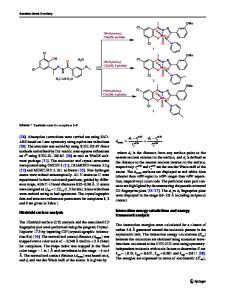A family of coordination polymers derived from a flexible dicarboxylic acid and auxiliary N-donor ligands: solvothermal
- PDF / 4,978,099 Bytes
- 12 Pages / 595.276 x 790.866 pts Page_size
- 16 Downloads / 311 Views
A family of coordination polymers derived from a flexible dicarboxylic acid and auxiliary N‑donor ligands: solvothermal synthesis, crystal structure and dye adsorption properties Xian‑Gui Mu1 · Yan‑Hong Zhang1,2 · Li‑Na Wang1 · Shuang Jiang1 Received: 22 July 2020 / Accepted: 2 November 2020 © Springer Nature Switzerland AG 2020
Abstract Four novel coordination polymers [Cd2(oba)2(phen)2]n (1), [Mn3(oba)3(phen)2]n (2), [Zn(oba)(phen)]n (3) and [Mn(oba) (dmphen)]n (4) (H2oba = 4,4′-oxybis (benzoic acid), phen = 1,10-phenanthroline, dmphen = 2,9-dimethyl-1,10-phenanthroline) have been synthesized by the solvothermal method and then characterized by single-crystal X-ray diffraction, elemental analysis, infrared spectrum, UV–Vis spectroscopy and thermogravimetric analysis. Structural analysis suggests that complex 1 displays a 1D ribbon-like structure, which extends into a 2D supramolecular layer by intermolecular π⋯π stacking. For complex 2, the trinuclear building unit of [Mn3(oba)3(phen)2] bridged by the oba2− ligands leads to the formation of a 3D supramolecular network. Complex 3 adopts a mononuclear and 1D zigzag chain structure and also extends into a 2D supramolecular network by intermolecular π⋯π stacking. Complex 4 shows 1D infinite double-chain structures which are shaped by intermolecular π⋯π stackings. Photoluminescent properties of complexes 1 and 3 in solid state were also studied. In addition, complex 2 exhibits high performance in the selective adsorption of Congo red (CR) with an adsorption capacity of 64.4 mg g−1.
Introduction Organic dyes have been widely used in many industrial fields, e.g., in paper, printing, plastics, textiles, cosmetics, pharmaceuticals and so on [1–3]. Most of dye materials are difficult to degrade due to their physical and chemical resistance to light and oxidants. So, the toxicities of several dyes have presented a great deal of long-term threat to the environment and are of serious concerns to the public health, such as aesthetic pollution, even carcinogenicity and perturbation to aquatic species [4–6]. Therefore, new Electronic supplementary material The online version of this article (https://doi.org/10.1007/s11243-020-00438-0) contains supplementary material, which is available to authorized users. * Yan‑Hong Zhang [email protected] 1
Key Laboratory of Excitonic Materials Chemistry and Devices, College of Chemistry and Environment Science, Inner Mongolia Normal University, Hohhot 010022, China
Key Laboratory of Advanced Energy Materials Chemistry (Ministry of Education), College of Chemistry, Nankai University, Tianjin 300071, China
2
technologies with high efficiency and low cost to remove and/or decompose dye stuffs from industrial or agricultural wastewater are urgently needed in order to achieve a clean and friendly environment. Recently, coordination polymers (CPs) or metal–organic frameworks (MOFs) have been extensively used for adsorbing and separating dye molecules, due to their high surface area, large surface-to-volume ratio and available
Data Loading...











